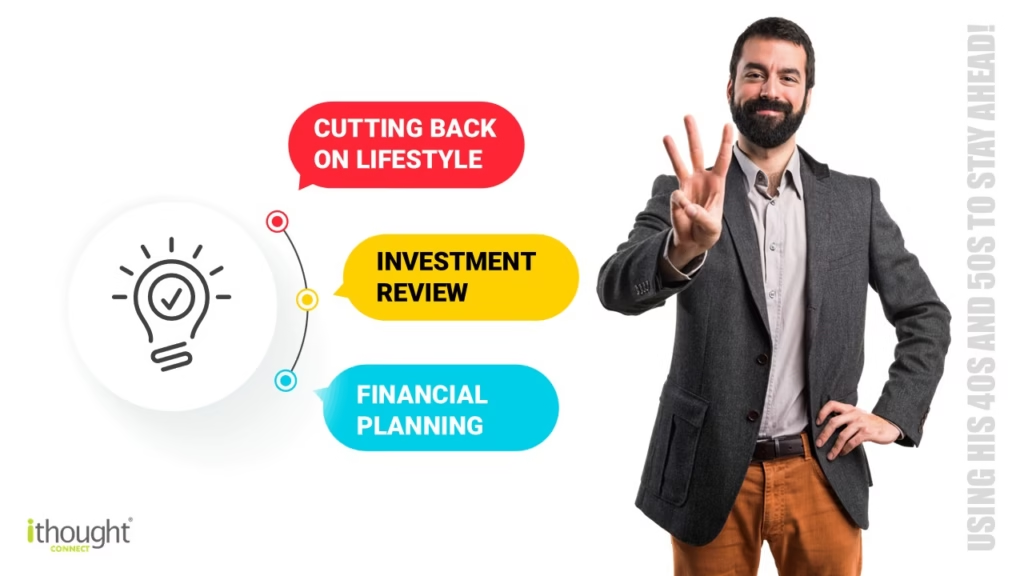
Most of us don’t take money seriously until we need to. Santhosh certainly did so. When he started working, he had no financial worries. His parents were in good health and financially independent. Santhosh was footloose and fancy free. As his career in the IT took off, each year brought in a fresh set of bonuses and raises. Doing well meant living better and the good times were here to stay. Retirement was still a few decades away, while the good life was in the here and now.
In fact, during the first fifteen years of his career, Santosh never felt the urgency to save for the long run. A marriage and two kids later – school fees, vacations, parents’ expenses were all funded through paychecks and bonuses. Retirement money slowly accumulated in his provident fund.
Yet, as time passed on, Santhosh began to worry about money. The lifestyle of his twenties was a thing of the past. He knew he needed more to live well but had no idea how much he would need in his nest egg. He had given some thought to his children’s education needs. Santhosh had stashed away money in a children’s insurance policy specifically designed for their higher education, but those investments hadn’t performed to expectation. He would somehow have to play catch up. Beyond that there wasn’t too much by way of savings. The family had great memories from their yearly foreign vacations, but whether he wasn’t confident that he could send his children abroad to study. And then it dawned on Santhosh: was he screwed?
The job market wasn’t great. The IT industry was going through turmoil. While he was a high performer, he wasn’t sure that he’d see the kind of career and compensation growth of the last decade. Given his skill sets, there weren’t too many other career options on the table. Santhosh didn’t have a game plan – and this kept him up at night. If you’re like Santhosh, there’s light at the end of the tunnel.
Starting to save in your forties is less than ideal, but it’s not the end of the world either. It entails a lot of hard work, timely execution, and can be a little taxing on your financial resources. Here’s how Santhosh used his 40s and 50s to get ahead and stay ahead.

Cutting Back on Lifestyle
Santhosh knew that the easiest way to save more was to cut back on his lifestyle. That meant eating out less, looking at foreign vacations every alternate year, and postponing purchasing a car. His logic was simple: how much he saved was directly in his control, how much he earned depended on how well his company did as well.
Investment Review
Next on Santhosh’s priority list was to take a hard look at his investments. He had mindlessly saved money in fixed deposits through the years. He had an assortment of life insurance policies from a variety of bankers. When he measured the returns they delivered, he was quite disappointed, even a vanilla FD would have done a better job. Over the years, he had built a speculative stock portfolio based on tips from friends, colleagues, and families. This had yielded average returns and Santhosh felt it was time to stop playing games and hand it over to a professional. The only thing that was going per plan was his PF contribution.
Santhosh decided automated savings were the best thing that happened to him – it forced him to be disciplined and consistent. So, he began putting away money into an NPS account for retirement. He even started an SIP to build a mutual fund portfolio for his children. He liquidated the insurance policies and ploughed them back into mutual funds. He liquidated his hobby stock portfolio and broke some of his fixed deposits to subscribe to a well-managed portfolio management service.
Next on Santhosh’s agenda was to consolidate the three real estate investments he and his wife had built over the last two decades. While there was no urgency to sell, Santhosh was cognizant that these properties didn’t fit into his personal or financial goals. The clean up would bring in much needed liquidity.
Financial Planning
Santhosh wanted to get the ball rolling before planning. Planning helped Santhosh answer the big questions:
- How much did he need to set aside for his children’s education?
- What would a comfortable retirement corpus entail?
- What was a healthy savings ratio?
- What would an ideal asset allocation look like in ten years?
Starting late forced Santhosh to get into accelerate mode. The next 15 years were like running on a financial treadmill. With consistency, planning, and a milestone approach Santhosh built the retirement corpus of his dreams. While it’s never too late to start, starting late limits your options. So, why wait. Get started today.
